Endangered Species
An endangered species is a type of organism that is threatened by extinction. Species become endangered for two main reasons: loss of habitat and loss of genetic variation.
Biology, Ecology, Geography, Conservation

Loading ...

An endangered species is a type of organism that is threatened by extinction . Species become endangered for two main reasons: loss of habitat and loss of genetic variation . Loss of Habitat A loss of habitat can happen naturally. Nonavian dinosaurs , for instance, lost their habitat about 65 million years ago. The hot, dry climate of the Cretaceous period changed very quickly, most likely because of an asteroid striking Earth. The impact of the asteroid forced debris into the atmosphere , reducing the amount of heat and light that reached Earth’s surface. The dinosaurs were unable to adapt to this new, cooler habitat. Nonavian dinosaurs became endangered, then extinct . Human activity can also contribute to a loss of habitat. Development for housing, industry , and agriculture reduces the habitat of native organisms. This can happen in a number of different ways. Development can eliminate habitat and native species directly. In the Amazon rainforest of South America, developers have cleared hundreds of thousands of acres. To “clear” a piece of land is to remove all trees and vegetation from it. The Amazon rainforest is cleared for cattle ranches , logging , and ur ban use. Development can also endanger species indirectly. Some species, such as fig trees of the rainforest, may provide habitat for other species. As trees are destroyed, species that depend on that tree habitat may also become endangered. Tree crowns provide habitat in the canopy , or top layer, of a rainforest . Plants such as vines, fungi such as mushrooms, and insects such as butterflies live in the rainforest canopy. So do hundreds of species of tropical birds and mammals such as monkeys. As trees are cut down, this habitat is lost. Species have less room to live and reproduce . Loss of habitat may happen as development takes place in a species range . Many animals have a range of hundreds of square kilometers. The mountain lion ( Puma concolor ) of North America, for instance, has a range of up to 1,000 square kilometers (386 square miles). To successfully live and reproduce, a single mountain lion patrols this much territory. Urban areas , such as Los Angeles, California, U.S.A., and Vancouver, British Columbia, Canada, grew rapidly during the 20th century. As these areas expanded into the wilderness, the mountain lion’s habitat became smaller. That means the habitat can support fewer mountain lions. Because enormous parts of the Sierra Nevada, Rocky, and Cascade mountain ranges remain undeveloped, however, mountain lions are not endangered. Loss of habitat can also lead to increased encounters between wild species and people. As development brings people deeper into a species range, they may have more exposure to wild species. Poisonous plants and fungi may grow closer to homes and schools. Wild animals are also spotted more frequently . These animals are simply patrolling their range, but interaction with people can be deadly. Polar bears ( Ursus maritimus ), mountain lions, and alligators are all predators brought into close contact with people as they lose their habitat to homes, farms , and businesses. As people kill these wild animals, through pesticides , accidents such as collisions with cars, or hunting, native species may become endangered.
Loss of Genetic Variation Genetic variation is the diversity found within a species. It’s why human beings may have blond, red, brown, or black hair. Genetic variation allows species to adapt to changes in the environment. Usually, the greater the population of a species, the greater its genetic variation. Inbreeding is reproduction with close family members. Groups of species that have a tendency to inbreed usually have little genetic variation, because no new genetic information is introduced to the group. Disease is much more common, and much more deadly, among inbred groups. Inbred species do not have the genetic variation to develop resistance to the disease. For this reason, fewer offspring of inbred groups survive to maturity. Loss of genetic variation can occur naturally. Cheetahs ( Acinonyx jubatus ) are a threatened species native to Africa and Asia. These big cats have very little genetic variation. Biologists say that during the last Ice Age , cheetahs went through a long period of inbreeding. As a result, there are very few genetic differences between cheetahs. They cannot adapt to changes in the environment as quickly as other animals, and fewer cheetahs survive to maturity. Cheetahs are also much more difficult to breed in captivity than other big cats, such as lions ( Panthera leo ). Human activity can also lead to a loss of genetic variation. Overhunting and overfishing have reduced the populations of many animals. Reduced population means there are fewer breeding pairs . A breeding pair is made up of two mature members of the species that are not closely related and can produce healthy offspring. With fewer breeding pairs, genetic variation shrinks. Monoculture , the agricultural method of growing a single crop , can also reduce genetic variation. Modern agribusiness relies on monocultures. Almost all potatoes cultivated , sold, and consumed, for instance, are from a single species, the Russet Burbank ( Solanum tuberosum ). Potatoes, native to the Andes Mountains of South America, have dozens of natural varieties. The genetic variation of wild potatoes allows them to adapt to climate change and disease. For Russet Burbanks, however, farmers must use fertilizers and pesticides to ensure healthy crops because the plant has almost no genetic variation. Plant breeders often go back to wild varieties to collect genes that will help cultivated plants resist pests and drought, and adapt to climate change. However, climate change is also threatening wild varieties. That means domesticated plants may lose an important source of traits that help them overcome new threats. The Red List The International Union for Conservation of Nature (IUCN) keeps a “Red List of Threatened Species.” The Red List de fines the severity and specific causes of a species’ threat of extinction. The Red List has seven levels of conservation: least concern , near threatened , vulnerable, endangered, critically endangered , extinct in the wild , and extinct. Each category represents a different threat level. Species that are not threatened by extinction are placed within the first two categories—least concern and near-threatened. Those that are most threatened are placed within the next three categories, known as the threatened categories —vulnerable, endangered, and critically endangered. Those species that are extinct in some form are placed within the last two categories—extinct in the wild and extinct. Classifying a species as endangered has to do with its range and habitat, as well as its actual population. For this reason, a species can be of least concern in one area and endangered in another. The gray whale ( Eschrichtius robustus ), for instance, has a healthy population in the eastern Pacific Ocean, along the coast of North and South America. The population in the western Pacific, however, is critically endangered.
Least Concern Least concern is the lowest level of conservation . A species of least concern is one that has a widespread and abundant population. Human beings are a species of least concern, along with most domestic animals , such as dogs ( Canis familiaris ) and cats ( Felis catus ). Many wild animals, such as pigeons and houseflies ( Musca domestica ), are also classified as least concern. Near Threatened A near threatened species is one that is likely to qualify for a threatened category in the near future. Many species of violets , native to tropical jungles in South America and Africa, are near threatened, for instance. They have healthy populations, but their rainforest habitat is disappearing at a fast pace. People are cutting down huge areas of rainforest for development and timber . Many violet species are likely to become threatened. Vulnerable Species The definitions of the three threatened categories (vulnerable, endangered, and critically endangered) are based on five criteria: population reduction rate , geographic range, population size, population restrictions , and probability of extinction . Threatened categories have different thresholds for these criteria. As the population and range of the species decreases, the species becomes more threatened. 1) Population reduction rate A species is classified as vulnerable if its population has declined between 30 and 50 percent. This decline is measured over 10 years or three generations of the species, whichever is longer. A generation is the period of time between the birth of an animal and the time it is able to reproduce. Mice are able to reproduce when they are about one month old. Mouse populations are mostly tracked over 10-year periods. An elephant's generation lasts about 15 years. So, elephant populations are measured over 45-year periods. A species is vulnerable if its population has declined at least 50 percent and the cause of the decline is known. Habitat loss is the leading known cause of population decline. A species is also classified as vulnerable if its population has declined at least 30 percent and the cause of the decline is not known. A new, unknown virus , for example, could kill hundreds or even thousands of individuals before being identified. 2) Geographic range A species is vulnerable if its “ extent of occurrence ” is estimated to be less than 20,000 square kilometers (7,722 square miles). An extent of occurrence is the smallest area that could contain all sites of a species’ population. If all members of a species could survive in a single area, the size of that area is the species’ extent of occurrence. A species is also classified as vulnerable if its “ area of occupancy ” is estimated to be less than 2,000 square kilometers (772 square miles). An area of occupancy is where a specific population of that species resides. This area is often a breeding or nesting site in a species range. 3) Population size Species with fewer than 10,000 mature individuals are vulnerable. The species is also vulnerable if that population declines by at least 10 percent within 10 years or three generations, whichever is longer. 4) Population restrictions Population restriction is a combination of population and area of occupancy. A species is vulnerable if it is restricted to less than 1,000 mature individuals or an area of occupancy of less than 20 square kilometers (8 square miles). 5) Probability of extinction in the wild is at least 10 percent within 100 years. Biologists, anthropologists, meteorologists , and other scientists have developed complex ways to determine a species’ probability of extinction. These formulas calculate the chances a species can survive, without human protection, in the wild. Vulnerable Species: Ethiopian Banana Frog The Ethiopian banana frog ( Afrixalus enseticola ) is a small frog native to high- altitude areas of southern Ethiopia. It is a vulnerable species because its area of occupancy is less than 2,000 square kilometers (772 square miles). The extent and quality of its forest habitat are in decline. Threats to this habitat include forest clearance, mostly for housing and agriculture. Vulnerable Species: Snaggletooth Shark The snaggletooth shark ( Hemipristis elongatus ) is found in the tropical, coastal waters of the Indian and Pacific Oceans. Its area of occupancy is enormous, from Southeast Africa to the Philippines, and from China to Australia. However, the snaggletooth shark is a vulnerable species because of a severe population reduction rate. Its population has fallen more than 10 percent over 10 years. The number of these sharks is declining due to fisheries, especially in the Java Sea and Gulf of Thailand. The snaggletooth shark’s flesh, fins, and liver are considered high-quality foods. They are sold in commercial fish markets, as well as restaurants. Vulnerable Species: Galapagos Kelp Galapagos kelp ( Eisenia galapagensis ) is a type of seaweed only found near the Galapagos Islands in the Pacific Ocean. Galapagos kelp is classified as vulnerable because its population has declined more than 10 percent over 10 years. Climate change is the leading cause of decline among Galapagos kelp. El Niño, the natural weather pattern that brings unusually warm water to the Galapagos, is the leading agent of climate change in this area. Galapagos kelp is a cold-water species and does not adapt quickly to changes in water temperature.
Endangered Species 1) Population reduction rate A species is classified as endangered when its population has declined between 50 and 70 percent. This decline is measured over 10 years or three generations of the species, whichever is longer. A species is classified as endangered when its population has declined at least 70 percent and the cause of the decline is known. A species is also classified as endangered when its population has declined at least 50 percent and the cause of the decline is not known. 2) Geographic range An endangered species’ extent of occurrence is less than 5,000 square kilometers (1,930 square miles). An endangered species’ area of occupancy is less than 500 square kilometers (193 square miles). 3) Population size A species is classified as endangered when there are fewer than 2,500 mature individuals. When a species population declines by at least 20 percent within five years or two generations, it is also classified as endangered. 4) Population restrictions A species is classified as endangered when its population is restricted to less than 250 mature individuals. When a species’ population is this low, its area of occupancy is not considered. 5) Probability of extinction in the wild is at least 20 percent within 20 years or five generations, whichever is longer.
Endangered Species: Scimitar -horned Oryx The scimitar-horned oryx ( Oryx dammah ) is a species of antelope with long horns. Its range extends across northern Africa. Previously, the scimitar-horned oryx was listed as extinct in the wild because the last confirmed sighting of one was in 1988. However, the first group of scimitar-horned oryx was released back into the wild in Chad, in August 2016, and the population is growing. Overhunting and habitat loss, including competition with domestic livestock , are the main reasons for the decline of the oryx’s wild population. Captive herds are now kept in protected areas of Tunisia, Senegal, and Morocco. Scimitar-horned oryxes are also found in many zoos . Critically Endangered Species 1) Population reduction rate A critically endangered species’ population has declined between 80 and 90 percent. This decline is measured over 10 years or three generations of the species, whichever is longer. A species is classified as critically endangered when its population has declined at least 90 percent and the cause of the decline is known. A species is also classified as endangered when its population has declined at least 80 percent and the cause of the decline is not known. 2) Geographic range A critically endangered species’ extent of occurrence is less than 100 square kilometers (39 square miles). A critically endangered species’ area of occupancy is estimated to be less than 10 square kilometers (4 square miles). 3) Population size A species is classified as critically endangered when there are fewer than 250 mature individuals. A species is also classified as critically endangered when the number of mature individuals declines by at least 25 percent within three years or one generation, whichever is longer. 4) Population restrictions A species is classified as critically endangered when its population is restricted to less than 50 mature individuals. When a species’ population is this low, its area of occupancy is not considered. 5) Probability of extinction in the wild is at least 50 percent within 10 years or three generations, whichever is longer. Critically Endangered Species: Bolivian Chinchilla Rat The Bolivian chinchilla rat ( Abrocoma boliviensis ) is a rodent found in a small section of the Santa Cruz region of Bolivia. It is critically endangered because its extent of occurrence is less than 100 square kilometers (39 square miles). The major threat to this species is loss of its cloud forest habitat. People are clearing forests to create cattle pastures .
Critically Endangered Species: Transcaucasian Racerunner The Transcaucasian racerunner ( Eremias pleskei ) is a lizard found on the Armenian Plateau , located in Armenia, Azerbaijan, Iran, and Turkey. The Transcaucasian racerunner is a critically endangered species because of a huge population decline, estimated at more than 80 percent during the past 10 years. Threats to this species include the salination , or increased saltiness, of soil . Fertilizers used for agricultural development seep into the soil, increasing its saltiness. Racerunners live in and among the rocks and soil, and cannot adapt to the increased salt in their food and shelter. The racerunner is also losing habitat as people create trash dumps on their area of occupancy. Critically Endangered Species: White Ferula Mushroom The white ferula mushroom ( Pleurotus nebrodensis ) is a critically endangered species of fungus. The mushroom is critically endangered because its extent of occurrence is less than 100 square kilometers (39 square miles). It is only found in the northern part of the Italian island of Sicily, in the Mediterranean Sea. The leading threats to white ferula mushrooms are loss of habitat and overharvesting. White ferula mushrooms are a gourmet food item. Farmers and amateur mushroom hunters harvest the fungus for food and profit. The mushrooms can be sold for up to $100 per kilogram (2.2 pounds). Extinct in the Wild A species is extinct in the wild when it only survives in cultivation (plants), in captivity (animals), or as a population well outside its established range. A species may be listed as extinct in the wild only after years of surveys have failed to record an individual in its native or expected habitat.
Extinct in the Wild: Monut Kaala Cyanea The Mount Kaala cyanea ( Cyanea superba ) is a large, flowering tree native to the island of Oahu, in the U.S. state of Hawai‘i. The Mount Kaala cyanea has large, broad leaves and fleshy fruit. The tree is extinct in the wild largely because of invasive species. Non-native plants crowded the cyanea out of its habitat, and non-native animals such as pigs, rats, and slugs ate its fruit more quickly than it could reproduce. Mount Kaala cyanea trees survive in tropical nurseries and botanical gardens . Many botanists and conservationists look forward to establishing a new population in the wild. Extinct A species is extinct when there is no reasonable doubt that the last remaining individual of that species has died. Extinct: Cuban Macaw The Cuban macaw ( Ara tricolor ) was a tropical parrot native to Cuba and a small Cuban island, Isla de la Juventud. Hunting and collecting the birds for pets led to the bird’s extinction. The last specimen of the Cuban macaw was collected in 1864. Extinct: Ridley’s Stick Insect Ridley’s stick insect ( Pseudobactricia ridleyi ) was native to the tropical jungle of the island of Singapore. This insect, whose long, segmented body resembled a tree limb, is only known through a single specimen, collected more than 100 years ago. During the 20th century, Singapore experienced rapid development. Almost the entire jungle was cleared, depriving the insect of its habitat.
Endangered Species and People When a species is classified as endangered, governments and international organizations can work to protect it. Laws may limit hunting and destruction of the species’ habitat. Individuals and organizations that break these laws may face huge fines. Because of such actions, many species have recovered from their endangered status. The brown pelican ( Pelecanus occidentalis ) was taken off the endangered species list in 2009, for instance. This seabird is native to the coasts of North America and South America, as well as the islands of the Caribbean Sea. It is the state bird of the U.S. state of Louisiana. In 1970, the number of brown pelicans in the wild was estimated at 10,000. The bird was classified as vulnerable. During the 1970s and 1980s, governments and conservation groups worked to help the brown pelican recover. Young chicks were reared in hatching sites, then released into the wild. Human access to nesting sites was severely restricted. The pesticide DDT , which damaged the eggs of the brown pelican, was banned. During the 1980s, the number of brown pelicans soared. In 1988, the IUCN “delisted” the brown pelican. The bird, whose population is now in the hundreds of thousands, is now in the category of least concern.
Convention on Biological Diversity The Convention on Biological Diversity is an international treaty to sustain and protect the diversity of life on Earth. This includes conservation, sustainability, and sharing the benefits of genetic research and resources. The Convention on Biological Diversity has adopted the IUCN Red List of endangered species in order to monitor and research species' population and habitats. Three nations have not ratified the Convention on Biological Diversity: Andorra, the Holy See (Vatican), and the United States.
Lonesome George Lonesome George was the only living member of the Pinta Island tortoise ( Chelonoidis abingdoni ) known to exist. The Pinta Island tortoise was only found on Pinta, one of the Galapagos Islands. The Charles Darwin Research Station, a scientific facility in the Galapagos, offered a $10,000 reward to any zoo or individual for locating a single Pinta Island tortoise female. On June 25, 2012, Lonesome George died, leaving one more extinct species in the world.
Audio & Video
Articles & profiles, media credits.
The audio, illustrations, photos, and videos are credited beneath the media asset, except for promotional images, which generally link to another page that contains the media credit. The Rights Holder for media is the person or group credited.
Illustrators
Educator reviewer, last updated.
March 8, 2024
User Permissions
For information on user permissions, please read our Terms of Service. If you have questions about how to cite anything on our website in your project or classroom presentation, please contact your teacher. They will best know the preferred format. When you reach out to them, you will need the page title, URL, and the date you accessed the resource.
If a media asset is downloadable, a download button appears in the corner of the media viewer. If no button appears, you cannot download or save the media.
Text on this page is printable and can be used according to our Terms of Service .
Interactives
Any interactives on this page can only be played while you are visiting our website. You cannot download interactives.
Related Resources
Central Idea: Human Impacts
- Show/Hide Line Reader
- Learn It Part 1
- Learn It Part 2
- Conquer It Part 1
- Conquer It Part 2
- Exit Ticket
In the following activities, you will continue to uncover the central idea of the whole article by continuing to synthesize key details and thinking about what the author wants you to learn from the article. Finally, you will use the central idea from the article to develop an accurate summary of the text as a whole.
Continue reading the final paragraphs in “ From Many, to Few, to None Opens a new window , ” and then complete the activity.
Paragraph 6 These cautionary tales inspired reflection on the relationship of humans and nature, and led to a groundswell of public awareness of environmental problems and support for wildlife conservation. This was the start of the country's first environmental movement. The result was the regulation of hunting, the establishment of refuges and preserves, and the passage of conservation laws. Several years later, Congress passed the Endangered Species Act of 1973, which was to become the most important wildlife conservation law of our time and the primary means for federal agencies to protect imperiled species and their habitats. While contemporary conservation measures arrived too late to save the passenger pigeon and other species, this crucial law has kept hundreds of plants and animals from realizing this fate.
Paragraph 7 In the last 40 years, the Endangered Species Act has proved to be a remarkably successful tool for preventing extinction and steadily improving the conservation prospects for numerous dwindling species. Although significant progress has been made in safeguarding our nation's imperiled species, many still face formidable challenges to recovery. Many species continue to hang on by just the thread ESA protection provides them. And while some species with precariously low numbers may never recover to the point where ESA protection is no longer necessary for their survival, the status of many species has improved or stabilized. In the 40th year of its existence, the ESA is stronger than ever. It continues to represent an unwavering commitment to protect our native plants and animals for future generations.
— U.S. Fish & Wildlife Service , August 18, 2014
Central Idea Tip
Remember, the central idea develops over the course of the text. As a reader, it is important for you to keep track of the central idea by pausing after each section and asking yourself some important questions:
- What is the central idea of this section?
- Which key details support the central idea?
- How has the central idea changed from the last section I read?
- How is my understanding of this scientific concept deepening?
Tracing the development of the central idea will ensure that you truly understand the content presented by the author.
- Go to page 1
- Go to page 2
- Go to page 3
- Go to page 4
- Go to page 5
- Go to page 6
- Go to page 7
- Go to page 8
Teacher Resources | Accessibility
This website is a production of Maryland Public Television/Thinkport in collaboration with the Maryland State Department of Education. The contents of this website were developed under a grant from the U.S. Department of Education. However, those contents do not necessarily represent the policy of the U.S. Department of Education, and you should not assume endorsement by the Federal Government.

LEARNING TOOL
Preserving critical species: inquiry to action.
This activity guides students through a process that uses the College, Career, and Civic Life (C3) Framework inquiry arc. Students identify and research compelling and supporting questions, leading them to develop explanations and arguments and, ultimately, to take action on issues related to the preservation of species.
Biology, Oceanography, Ecology, Earth Science
Loading ...
This resource is also available in Spanish .
Preparation
Materials You Provide:
- Sticky notes (6 per student)
- Sticky notes per pair of students
Required Technology:
- Internet Access
- 1 computer per learner
- 1 computer per pair
- Interactive whiteboard
Physical Space:
- Media Center/Library
Critical species around the globe—and in our own backyards—face challenges that threaten their continued existence. These challenges come from a variety of situations in their unique habitats, including poaching and habitat loss. Many times animals and humans come into conflict, with animal conservation often losing the battle.
Students need to understand the interconnected issues that impact animal conservation. Understanding how geography, history, cultures, science, and civics (citizen action) impact the enduring issues around animal survival will help us identify problems and develop sustainable solutions.
The National Geographic Mission: Animal Rescue initiative aims to inspire kids to learn as much as possible about endangered animals and to take action to rescue them.
This understanding can be facilitated through an inquiry process that leads to action. The C3 Framework lays out a robust set of steps to guide students through the process. “The C3 Framework is centered on an inquiry arc—a set of interlocking and mutually supportive ideas that frame the ways students learn social studies content.[1]“ The framework is organized around four dimensions—or process steps—students follow to conduct their inquiry. These steps are abbreviated in this activity, but the full framework can be found at https://www.socialstudies.org/standards/c3 .
- Developing questions and planning inquiries
- Applying disciplinary tools and concepts
- Evaluating sources and using evidence
- Communicating conclusions and taking informed action
[1] National Council for the Social Studies (NCSS), The College, Career, and Civic Life (C3) Framework for Social Studies State Standards: Guidance for Enhancing the Rigor of K-12. Civics, Economics, Geography, and History (Silver Spring, MD: NCSS, 2013).
Students will:
- Identify key issues related to the protection of endangered or threatened species.
- Construct compelling and supporting questions that frame and guide inquiry related to the protection of endangered or threatened species.
- Identify and evaluate sources that will help answer compelling and supporting questions, taking into consideration multiple points of view, the structure of an argument or explanation, the types of sources available and the potential uses of the sources.
- Conduct research that results in the formulation of an explanation or argument related to the key/enduring issues of the topic.
- Communicate an explanation or argument based on research using appropriate media (text, video, graphics, maps, etc.).
- Take informed action as a result of the implementation of the inquiry arc.
Teaching Approach: inquiry-based learning, learning-for-use
Teaching Methods: discussions, inquiry, research
Skills Summary
This activity targets the following skills:
- Information Literacy
- Communication and Collaboration
- Critical Thinking and Problem Solving
- Global Awareness
- Understanding
- Analyzing Geographic Information
- Answering Geographic Questions
- Asking Geographic Questions
- Organizing Geographic Information
- Asking questions (for science) and defining problems (for engineering)
- Constructing explanations (for science) and designing solutions (for engineering)
- Obtaining, evaluating, and communicating information
1. For the purpose of this activity, you will be guided through implementing the College, Career, and Civic Life (C3) Framework. “The C3 Framework is centered on an inquiry arc—a set of interlocking and mutually supportive ideas that frame the ways students learn social studies content.[1]“ The framework is organized around four dimensions—or process steps—students follow to conduct their inquiry. These steps are abbreviated in this activity, but the full framework can be found at https://www.socialstudies.org/standards/c3 .
2. To begin, activate students' prior knowledge by engaging them in a discussion about endangered species. Ask:
- What does it mean that a species or animal is endangered?
- What are some animals you think are threatened or endangered? (You may wish to talk about the difference between a species being endangered and a species being threatened. An endangered species is one that is in danger of extinction throughout all or a significant portion of its range. A threatened species is one that is likely to become an endangered species within the foreseeable future throughout all or a significant portion of its range.)
- What factors cause an animal to become endangered? (Student responses should include factors such as overhunting or overfishing, loss of habitat due to natural or manmade causes, poaching, etc.)
- How are issues around endangered animals related to the history of the areas the animals live in? To the cultures of the people who live in those areas? (Talk about the interconnections that are involved in any enduring issue.)
- What conflicts do you know about between animals and humans where you live? (Examples might include increased numbers of deer or other wild animals entering the community, poachers killing animals out of season, or arguments among people about how animals should or should not be protected.)
3. Provide students with the list of National Geographic online resources listed below—or combine resources on this list with other resources you have available, either online or in books or other sources. Ask students to work individually or in pairs to read some or all of the resources and, as they read, to take notes on key points they find in the information and any questions that come to mind.
- Endangered Species Encyclopedic Entry
- Search on https://education.nationalgeographic.org/ or https://www.nationalgeographic.com/ . (Use term “endangered species” or search on a specific species)
4. When students have had enough time to read through some of all of the sources, bring them back together and discuss their findings. Ask students to state questions they had as they went through the material. Write the questions on the board or flipchart paper. Have the class identify common types of questions—common issues that came up. Don’t discuss possible answers to questions at this time.
5. Ask students to reflect back on their own notes and on the list of questions the class identified. Then ask each student to identify a key question or concern they have related to endangered species. These questions should be questions that cover important concepts rather than trivial facts. They should lead to thinking about causes, rationale, problems, or multiple perspectives on the issue at hand. An example of a key or enduring issue might be understanding why it is so difficult to stop poaching of elephants in Africa or the ongoing conflict between ranchers and wolves in the American West. You might wish to have students focus on local or regional issues related to animal conservation and/or animal/human interactions, rather than on endangered or threatened species in other parts of the world. Have students write their enduring issue or concern on sticky notes and then put their notes on a poster or flip chart. When all students have written and posted an issue or concern, read them aloud to the class.
6. Introduce the concept of compelling questions to the class. Tell students that compelling questions are questions that focus on enduring issues. They deal with curiosities about how things work, interpretations of concepts, and unresolved issues that require students to construct arguments in response. A compelling question that students might generate is, “Why do we need rules?”—a question that reflects a social concern students have and an enduring issue in social studies. Have students go back to the enduring issues they developed and consider how these might be turned into compelling questions. Ask students to frame one compelling question that interests them about endangered species.
7. Then guide students in the remainder of the process as briefly outlined below:
- From the compelling question, write two to three supporting questions—smaller questions that contribute to understanding the compelling question. Supporting questions focus on descriptions, definitions, and processes, and they require students to construct an explanation. A supporting question for the compelling question above might be, “What are some school rules?”
- With a compelling question and some supporting questions in mind, students should think about resources that will help them find answers, “taking into consideration the multiple points of view represented in an argument, the structure of an explanation, the types of sources available, and the potential use of the sources[2].”
- Have students go back to the resources you introduced earlier to look for information that will help them understand the concepts related to endangered species as they pertain to their compelling and supporting questions. Provide any other resources available in the classroom, including textbooks, online resources, as well as the school library. If any students have similar compelling questions, allow them time to meet to discuss what information will be important to gather and also what arguments they might make related to their enduring issue.
- Guide students in the process of evaluating sources and developing claims, using evidence to support the claims.
- Ask students to formalize their arguments or explanations related to their enduring issue—compelling question—by communicating their results in the form of an oral presentation using posters or PowerPoint or another form of multimedia presentation. Because the issues surrounding endangered species are so closely tied to geography, have students include maps in their presentations—making sure to make significant ties between the explanation or argument and the related map resources and tools.
8. The final step in the C3 Framework process involves not only communicating results but also taking informed action. Ask students to brainstorm actions that might result from their research. For example, students might suggest writing letters to their state or national congressional representatives, or letters to the editor. They might also look into species preservation issues in their communities.
Informal Assessment
Utilize a rubric, provided to students in advance of the activity, for assessing students’ inquiry process and/or their final presentation. Also, have students write a short self-assessment describing their reactions to the inquiry process and what they discovered in the process.
Connections to National Standards, Principles, and Practices
National Council for Social Studies Curriculum Standards
- Theme 3 : People, Places, and Environments
- Theme 8 : Science, Technology, and Society
- Theme 9 : Global Connections
National Geography Standards
- Standard 1 : How to use maps and other geographic representations, geospatial technologies, and spatial thinking to understand and communicate information
- Standard 17 : How to apply geography to interpret the past
- Standard 18 : How to apply geography to interpret the present and plan for the future.
- Standard 3 : How to analyze the spatial organization of people, places, and environments on Earth's surface
National Science Education Standards
- (5-8) Standard C-1 : Structure and function in living systems
- (5-8) Standard F-2 : Populations, resources, and environments
- (9-12) Standard F-3 : Natural resources
- (9-12) Standard F-4 : Environmental quality
- (9-12) Standard F-5 : Natural and human-induced hazards
Media Credits
The audio, illustrations, photos, and videos are credited beneath the media asset, except for promotional images, which generally link to another page that contains the media credit. The Rights Holder for media is the person or group credited.
Last Updated
April 18, 2024
User Permissions
For information on user permissions, please read our Terms of Service. If you have questions about how to cite anything on our website in your project or classroom presentation, please contact your teacher. They will best know the preferred format. When you reach out to them, you will need the page title, URL, and the date you accessed the resource.
If a media asset is downloadable, a download button appears in the corner of the media viewer. If no button appears, you cannot download or save the media.
Text on this page is printable and can be used according to our Terms of Service .
Interactives
Any interactives on this page can only be played while you are visiting our website. You cannot download interactives.
Related Resources
If you're seeing this message, it means we're having trouble loading external resources on our website.
If you're behind a web filter, please make sure that the domains *.kastatic.org and *.kasandbox.org are unblocked.
To log in and use all the features of Khan Academy, please enable JavaScript in your browser.
Digital SAT Reading and Writing
Course: digital sat reading and writing > unit 2.
- Central ideas and details | Lesson
Central Ideas and Details — Worked example
- Central Ideas and Details — Quick example
- Central ideas and details: foundations
Want to join the conversation?
- Upvote Button navigates to signup page
- Downvote Button navigates to signup page
- Flag Button navigates to signup page

Video transcript

InquiryBeing

Sharing the Planet: Our Journey Through Inquiry
Introduction:.
This time last year I had been left disappointed with the learning and teaching of my current inquiry. I found the scope too narrow, not enough depth for ‘real’ inquiry. I had not been looking forward to beginning it again. It was time for a rethink. I decided to approach the inquiry in a new way. My way did not work so lets see if we can change things. I decided to let things go and see where the children took me. It was time for greater student agency. I have documented the whole process and hope that you enjoy the journey. I have included a variety of learning but not all.
Please leave comments of what you think worked and how this could be improved. I am very open and welcoming to positive criticism.
Transdisciplinary Theme: Sharing the planet:
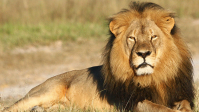
Central Idea: Animals and people interact in different ways in different contexts.
Lines of Inquiry:
- The different roles animals play in people’s lives.
- Suitability of particular animals for specific functions.
- Our responsibility for the well-being of animals.
Before we begin an inquiry I believe that it is always important to begin with the ‘Why’? This is based on the work of Simon Sinek. I have introduced this to my practice during the last couple of years and I have found that it really adds purpose to the inquiry and a logical progression in thinking. It provides a core purpose to the inquiry and why we do what we do.

- Children recognise the important connection between humans and animals
- Through research the children will become ‘experts’ on a particular animal and develop greater understanding on others.
- Responsibilities.
- Human Impact.
- The role animals play in our every day lives.
Provocations and Invitations:

‘Environments are invitations for inquiry. These environments have the potential to promote learning processes where children engage with one another and with meaningful materials exploring, constructing and representing their understanding and theories’ Louise Jupp
Writing stations were organised to provide prompts for the children’s learning. This is helpful in supporting the language development with the inquiry. Providing language skills directly linked to the inquiry.
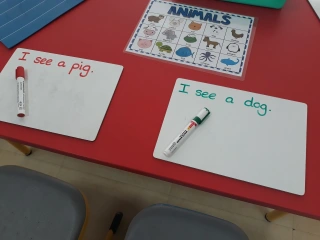
Our outside area would also play an important role in our inquiry as the children explore, question and investigate their natural environment. The learning experiences of the children’s independent interaction with the natural world have been invaluable throughout the year. We have recently built a sustainable garden which has to develop further the children’s connections with nature and a developing sense of responsibility.
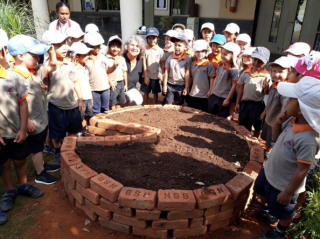
This is great I thought, so after some discussion I asked, ‘Which animals would you like to learn more about?’ Straight away hands went up, ‘Black Panthers, Tigers, Rabbits, Ducks, Dogs, Cats, Polar Bears……’ the list went on.
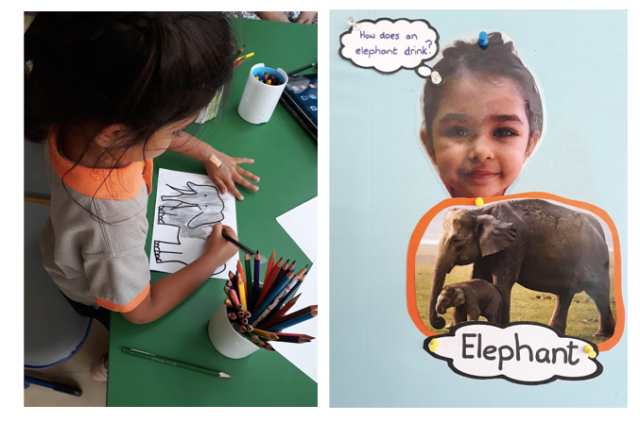
We began by choosing one of the children’s question. I had decided that I would use an example provided by one of my EAL students as they would need the most support. The question was “Where does a panda live?’ We then discussed where we could find the answer. ‘In a book? or on the internet’ some of the children suggested. So we searched YouTube to find a suitable vdeo all about pandas and recorded the information we discovered.
The information we discovered and recorded only led to more questions.
- What is mammal?
- What does endangered mean?
- What happens to animal when it become extinct?
And so our inquiry began to take shape……
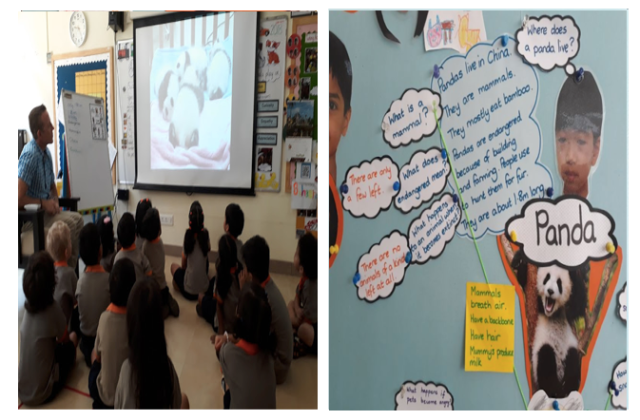
During the first week of the inquiry we also thought about and discussed our pets. This also seemed a natural starting point as pets are many of the children’s most important interactions with animals.

I also wanted to assess the children’s understanding about the concepts of pets. This would be important as we would begin to categories animals later in our inquiry. So I the asked the question, ‘What is a pet?’ and through discussion the children shared their thoughts and ideas which were recored on our board.
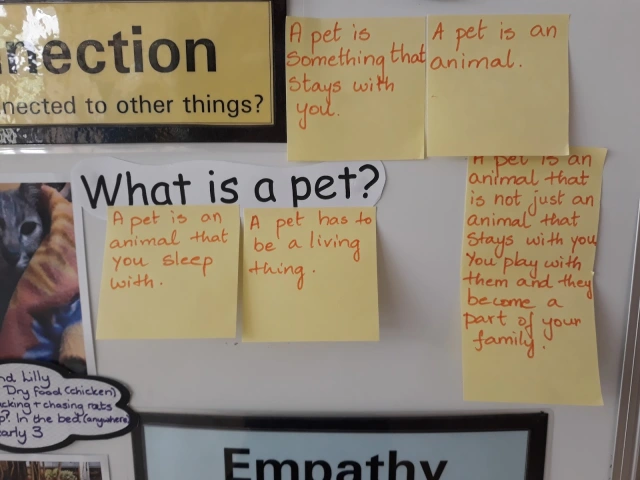
We also thought about the different roles our pets play in our daily lives. We came up with four very important roles, play, family, fun and friendship.
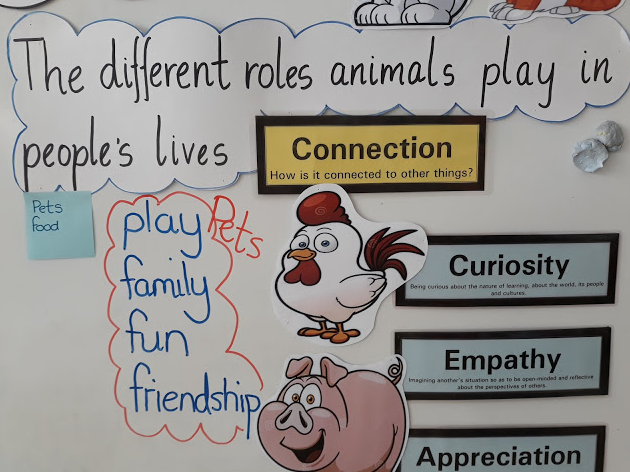
Finding-Out:
After our previous discussions regarding our pets we shared our ideas regarding our responsibilities. We shared our own thoughts, ideas and experiences. Many of the children had an excellent understanding of how to care and be responsible for their pets but we wanted to find out more.
We thought about the different ways that we can research information e.g. internet, books, or even just asking someone who is knowledgeable. We decided to try the internet and quickly found the video that explained the basic animal needs of pets.
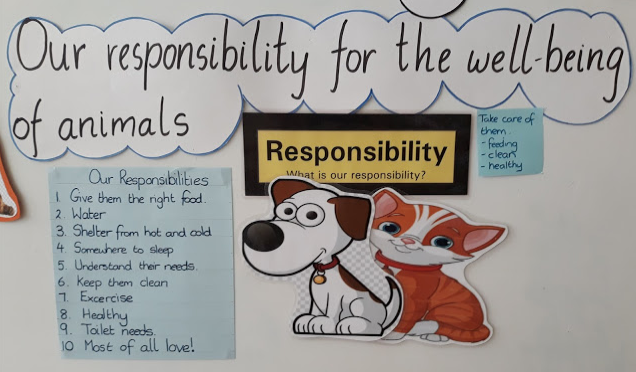
Sorting Out:
The joy of this inquiry has taken many directions which has been one of the greatest successes. The children were following their own path of learning with their questions being the driving force. As mentioned earlier, however, this had started to worry me slightly that the inquiry was becoming too broad. Would we ever come to the ‘why’ of the inquiry and if we did would there be enough time to inquire about this in depth?

Through the children’s independent questioning which were introduced to words like nocturnal, carnivore, herbivore, mammals, reptiles, birds etc. The children began to sort these animals into different groups based on these characteristics.
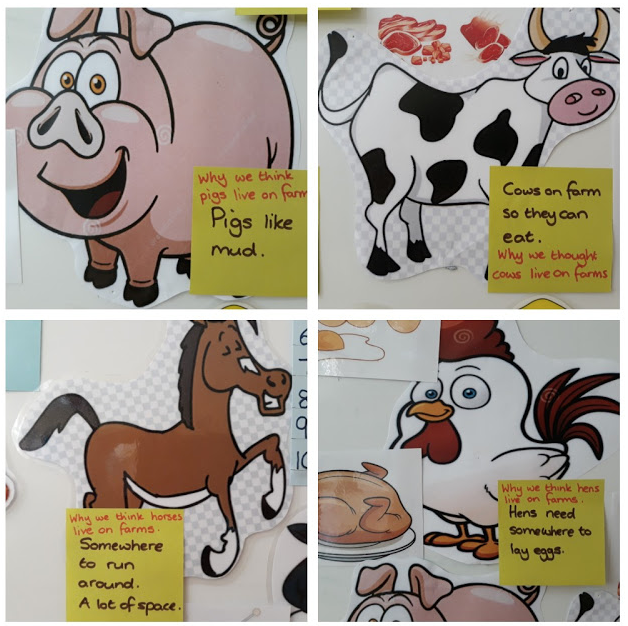
Through our research we developed a better understanding of the function of farm animals and their connection to our daily lives. Over the next week we decided that we would have a go at making our own produce. We made butter, cream, and even ice-cream. We learned a lot about the process of how some of our food gets from the farm to our plates.
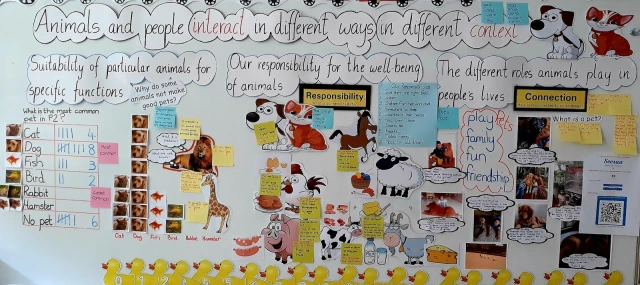
Going Further:
Throughout our inquiry the children have continued to research their chosen animal with support. This has led to many discussions regarding the different habitats where the animals lived. This led us to begin to study each of the habitats a little more closely. What we discovered was that many of the habitats were connected by the terrible effects of human behaviour. This learning really began to change the direction of our learning.
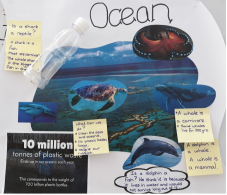
- Stop using plastic bags when we are shopping.
- Recycle our waste especially plastic which takes a very long time to decompose.
Who has made all this mess?! My teaching partner and I decided to provide a provocation to stimulate the children’s thinking about recycling. Her class were learning about different materials and my class had just begun to think about the concept of recycling. It seemed a perfect time to collaborate.
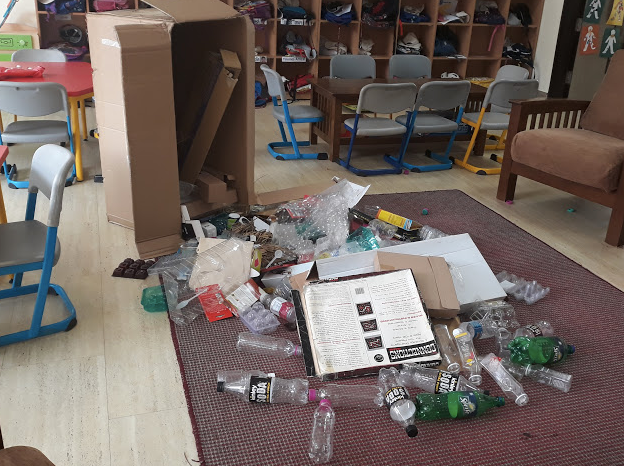
Making Conclusions:

‘ Action in the PYP. Taking action is an integral conclusion to the learning that incorporates students making connections to what they have learned, applying a variety of real life skills. ‘ Even our youngest learners are capable of meaningful Action.
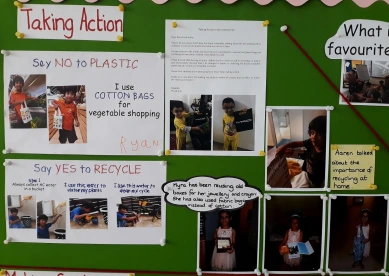
- We watched a video about the different ways hens are kept on farms e.g. free-range, caged, barn. After some discussion the children all decided that they would like to be free-range if they were hens. Some of the parents have now commented that the children have requested free-range eggs when they are at the supermarket.
- After our learning about plastic in our oceans some parents have commented on the children’s concerns about using plastic bags when shopping.
- Throughout the inquiry the children have demonstrated and developed greater care and empathy towards many of the animals they have encountered in our environment.
- Children have began to independently research animals delighting in sharing their new found knowledge.
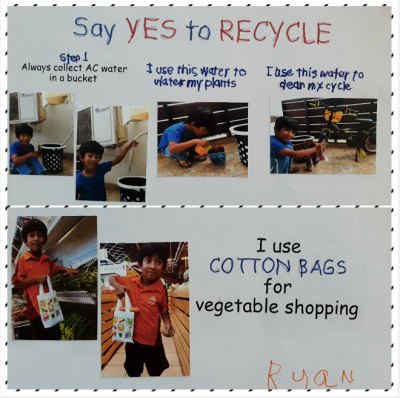
‘This is let you know that Vihan has been constantly talking about the devastating effect of plastic on our environment and what we can do to help.
He has spoken to the maids and security in our apartment to ensure that plastic bags are not being thrown away, instead reused and recycled.
Vihan noticed that the bag of spare clothes that he carries to school everyday, is plastic and immediately insisted that it be changed to paper or cloth bag. He found a suitable paper bag and is now carrying that to school.
Thank you very much for making the students aware of plastics and its effect on Earth. We really appreciate it’
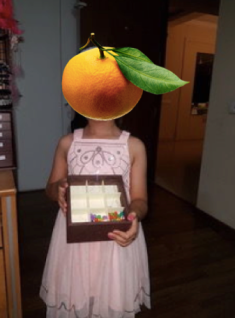
Student-Initiated Inquiries:
The pleasing element of this inquiry is that it has almost all been student initiated. it has been the children’s questions and curiosity that has really driven the inquiry. we have tried as much as possible to follow the children’s thinking. when possible we made connections between the work. insects:.
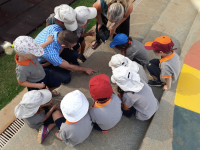
Step 2: Once in the classroom we remembered that one of the questions from last week was ‘What is an insect?’. I showed the children a variety of toy insects and we talked about what they all had in common. What made an insect an insect? This was a good opportunity to assess the children’s prior knowledge.
The children’s responses:
- Some have fur and some don’t.
- They are tiny.
- Some insects sting (The children gave many examples of themselves and family members being stung)
- Insects have 6 legs (I had to prompt them with this one by counting the legs)
Step 3: It was clear that we needed to find out more information. I asked the children how we could research to find out more. I was pleased that some answered with Youtube. this demonstrated that the children were becoming more aware of how technology can be used to support our learning. We searched YouTube and found a video all about insects to develop our knowledge and research skills.
Step 4: We discussed and shared the information that we found out. The children’s understanding of insects had quickly developed.
Children’s Findings:
- They don’t have bones but many do have a shell (exoskeleton).
- They are cold blooded so they prefer warm places but can be found anywhere in the world, even Antarctica!
- Most have wings and antenna.
- They hibernate.
- They lay eggs.
- Some insects change shape during their life.
What is the biggest animal?
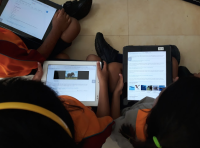
Step 2: We used our I.pads to research the question as a whole class activity. We want to support the children’s research skills.
Step 3: We found out the the elephant is the largest land animal. We also found out through our research that the giraffe was the tallest animal. This was great because our strand of Maths for this inquiry is measurement. We decided that we could measure how big and elephant is and how tall a giraffe is. We could then compare this to other animals we had already measured. Great opportunity to integrate our Maths objectives authentically into our unit of inquiry. Technology Integration:
When ever possible I try to make authentic technology integration within the learning. With our focus on research it has been quite easy to make this connection as the children have used a variety of web based searches to gain information regarding the animals e.g. google, Youtube etc. the children have been supported in how to find information with a developing independence.

This year I have been introduced to Seesaw, an online portfolio. It has made technology integration so much easier than ever before. We used Seesaw to label to different body parts of a variety of animals as this has been part of our science expectations for this inquiry.
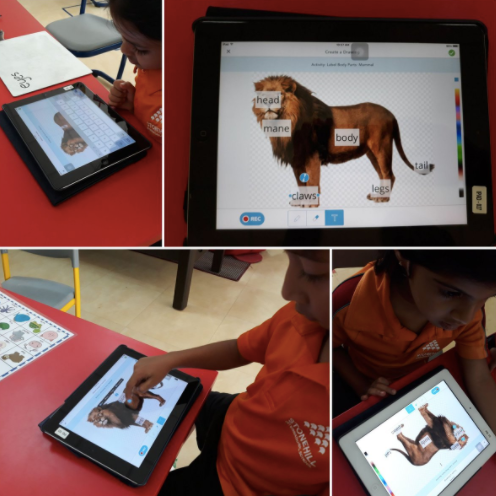
Conclusion:
It has been a very interesting learning journey. I can certainly say that it has been much more successful than the previous year it terms of learning and student engagement. We have tackled some ‘real world’ issues and the children have responded brilliantly. The amount of meaningful, authentic Action that took place made it all worth it. It has demonstrated that even our youngest learners are capable of taking Action. Through the inquiry we have created an awareness and developing understanding of Global issues which the children will take forward with them.
The whole process has made me reconsider my approach to both inquiry and assessment. I will certainly provide greater opportunity for children’s interest and thinking to drive the inquiry. I have also had to rethink the importance of creating a Summative Assessment task at the beginning of the inquiry, if they are needed at all. If we use detailed formative assessment throughout there is little need.
Share this:
Published by David Gostelow
I am an Early Childhood educator currently working in Thailand. As an experienced, and proud member, of the international learning community I enjoy the challenge and seek opportunities to support positive sustainable change to a community. I am passionate about providing innovative experiences for students to authentically engage in the whole creative thinking process; to make meaningful connections to the world around them; to solve problems; to develop a mindset for agency and responsible choices; and to develop their own voice. View all posts by David Gostelow
6 thoughts on “Sharing the Planet: Our Journey Through Inquiry”
Amazing unit..very well initiated inquiries..kudos
Great applause…deeply driven thinking process
A really wonderful unit, well done
This is amazing David! I’m new to PYP and haven’t had any training due to covid so am spending my summer holidays upskilling myself. I’ve listened to podcasts and done heaps of reading but finding real-life examples of what the inquiry process looks like in an early years classroom has been hard to find. Thank you so much for documenting this. Your inquiry looks outstanding. I’m going to share this with my team and follow your ideas. Thank you so much! I can’t wait to read more of your blog. Thanks, Jo
well explained.its my first time lin this curriculum,and l find it very interesting,Good work
Wow! well elaborated and so educative. Kudos!
Leave a comment Cancel reply

- Already have a WordPress.com account? Log in now.
- Subscribe Subscribed
- Copy shortlink
- Report this content
- View post in Reader
- Manage subscriptions
- Collapse this bar

Central Idea
Free lesson plans and resources to help your students identify topics, central ideas, and supporting details. Resources utilize short passages and focus on both stated and implied central ideas.
- ReadTheory >
- Lesson Plans >
- Central Idea >
Whole Week Overview
This week students will engage in deep dive into identifying topics, central ideas, supporting details in various short passages, as well as the difference between central ideas that are stated by the author versus implied.
CCSS.ELA-LITERACY.RI.3.2/4.2/5.2
Determine two or more main ideas of a text and explain how they are supported by key details; summarize the text.
- Teacher Guide
- Daily Powerpoints with Teacher Notes
- Printable Passages, Notes, Activities, Warm Ups, and Exit Tickets
- Short Standards-Focused Assessment
Day 1 - Introduction
Activate students’ prior knowledge by asking them to come up with their best definition for “Central Idea.”
Core Instruction
Using the guided notes and handouts, define central idea and introduce the central metaphor for the week: The Central Idea Sundae
Guided Practice
As a class, identify the topic of numerous photographs.
Independent Practice
Annotate the provided passages and begin identifying topics, central ideas, and whether those ideas are stated or implied. Exit tickets and checks for understanding are built into the Powerpoint as well.
Day 2 - Whole Class Practice
Students will practice identifying possible topics and central ideas of an image. Whole class will discuss.
Review the 3 essential ingredients of a central idea with students.
Annotate the provided passage (yesterday’s exit ticket) and a book cover as a class and begin identifying topics, central ideas, and whether those ideas are stated or implied.
Group Practice
Analyze two book covers and begin identifying topics, central ideas, and whether those ideas are stated or implied.
Students will craft short paragraphs focusing on supporting a central idea about themselves. Exit tickets and checks for understanding are built into the Powerpoint as well.
Day 3 - Working Backwards
Students will practice identifying possible topics and central ideas from images. Whole class will discuss.
Students will learn about how to work backwards from key details to determine a central idea.
Students will read supporting details as a class and practice forming central ideas from those details.
Students will read supporting details and practice forming central ideas from those details. Students will craft their own paragraphs and break them down into supporting details and central idea. Exit tickets and checks for understanding are built into the Powerpoint as well.
Day 4 - Group Practice
Students will review all elements of the week’s lessons: topic, supporting details, central idea.
Students will craft central idea statements with multiple passages. Exit tickets and checks for understanding are built into the Powerpoint as well.
Day 5 - Assessment
The assessment.
Hand out the assessment for students and then go over the directions:
- Read the passage carefully.
- Highlight/circle key details that communicate the central idea.
- Use the close sentence scaffold to write a central idea statement.
Students will also be asked to apply what they’ve learned to two passages.
Make sure to subscribe to our newsletter and be the first to know the news.
Lesson Plans
Bring readtheory to your school or district.
Please log in to save materials. Log in
- Resource Library
- Global Education
Education Standards
North carolina digital learning standards.
Learning Domain: Knowledge Constructor
Standard: Students build knowledge by actively exploring real-world issues and problems, developing ideas and theories and pursuing answers and solutions.
North Carolina English Language Arts Standards
Learning Domain: Reading: Informational Text
Standard: Determine the main idea of a text; recount the key details and explain how they support the main idea.
Standard: Use text features and search tools to locate information relevant to a given topic efficiently.
Standard: Distinguish their own point of view from that of the author of a text.
NC ISTE Standards for Students
Learning Domain: 1.3 Knowledge Constructor
Endangered Animal Project Rubric
Main Idea Exit Ticket
GEDB Introduction to Endangered Animals: Finding the Main Idea (Lesson 1 of 4)
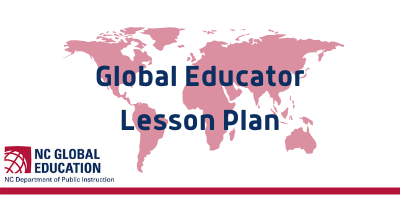
Students will learn to find main idea in a nonfiction text about endangered rhinoceroses. Main idea should be taught prior to this lesson using reading strategies. Students should already know main idea is what the text is mainly about in one sentence. Students should be able to locate the main idea in the topic sentence, heading, last sentence of the text, and know it may be found in text features. This lesson was developed by Ashley Wondra as part of their completion of the North Carolina Global Educator Digital Badge program. This lesson plan has been vetted at the local and state level for standards alignment, Global Education focus, and content accuracy.
Lesson Plan
Description
Students will learn to find main idea in a nonfiction text about endangered rhinoceroses. Main idea should be taught prior to this lesson using reading strategies. Students should already know main idea is what the text is mainly about in one sentence. Students should be able to locate the main idea in the topic sentence, heading, last sentence of the text, and know it may be found in text features.
Student Engagement/Motivation
Most people have a natural curiosity and love for animals. Today, we will begin learning about endangered animals in our nonfiction reading and writing units. Teacher will ask students to name an animal they believe may be endangered. Student responses will be posted on the board.
Learning Targets and Criteria for Success
Learning Targets
I can determine the main idea of a text and key details.
I can use my knowledge about text features to help me determine the main idea.
I can locate the author’s perspective.
I can build my background knowledge about endangered animals living in other countries.
Criteria for Success
I will use National Geographic Kids.com to research articles on rhinos.
I will use text features to locate the main idea and details in a text.
I will work with a group to discuss the author's point of view and compare it to my own.
Supplies/Resources
Computers, SMARTboard or projector
NationalGeographickids.com
Rhinos Airlifted to New Home article-
http://kids.nationalgeographic.com/explore/nature/rhinos-airlifted-to-new-home
Any nonfiction book about cheetahs
Helping Cheetahs: A Race to Survive article-
https://kids.nationalgeographic.com/explore/nature/cheetahs-race-to-survive/#cheetahs-survival-classroom
Chart paper with text features hanging around the classroom
(photos/captions, heading, bold print, italics, chart, map, sidebar)
Reading notebook
Chart paper for creating a poster
World Wildlife Fund e-card website-
http://wwf.worldwildlife.org/site/PageServer?pagename=WWF_Free_Ecards&_ga=2.216807891.495776190.1505024345-1643744332.1505024345
Learning Tasks and Practice
The teacher will begin by using Rhinos Airlifted to New Home article to model the learning task. The teacher will show students how to locate the text features like headings, bold words, pictures, captions, table of contents, chart, sidebar, glossary, or hyperlink. Teacher will use the same article to model using headings, pictures, captions and a hyperlink to find the main idea and author's point of view. The teacher will need any nonfiction book about cheetahs to model using any other text features to find the main idea. The teacher will show students the chart paper placed around the room. Each piece of chart paper should have a text feature displayed on it. The teacher will write the main idea of the text used on a sticky note. Then, the teacher will model by adding the sticky note to the chart that matches the text feature that helped locate the main idea. Finally, the teacher will read and discuss the author's point of view of the text and share their own point of view with the class.
The teacher should have copies of the Helping Cheetahs: A Race to Survive article, give students access to the same article or give each group a different article to analyze. Students will need a copy of the article for each group member to read or computers for the students to access it online.
1. Teacher says,"In groups of four, you will read, discuss, and decipher the information from the cheetahs article in order to collect the main idea and three details."
2. Students will take notes with their group and discuss the main idea and details. They will work together to determine the main idea of the text and write it on a sticky note along with three details.
3. One student from the group will place the sticky note response on the chart with the text feature that was most helpful to them when finding the main idea.
4. Students in the group will find the author’s point of view in the text and write it in their reading notebooks.
5. One student from each group will be the spokesperson to share which text feature their group used to help them locate the main idea of the text. Students should also tell why the chosen text feature was helpful to their group and what the author’s point of view is in the text.
6. Students will complete the Main Idea Exit Ticket.
7. Students can continue this lesson on the same day or a different day if more time is needed.
Technological Engagement
Teacher will use the SMARTboard. A projector could also be used if the teacher does not have access to a SMARTboard.
Students will use computers to visit National Geographic Kids.com to read the article Helping Cheetahs: A Race to Survive. If computers are not available, the teacher can print the article for students to view and read.
As an optional extention activity, students can send an e-postcard to family or friends to show how people can help endangered animals. See the extented learning opportunity section for more information.
Collecting and Documenting Evidence of Learning
Students will work in a group of four to read the Helping Cheetahs: A Race to Survive article, take notes and find the main idea, and details. Students will write their main idea on a sticky note and place it on the text feature charts around the room to show what text feature helped their group find the main idea and details.Student learning will be assessed through observation of group discussion about the main idea and details. Students will also complete the Main Idea Exit Ticket.
Student Self-Reflection and Action Steps
Students will read all responses on the sticky notes and text features charts. They will be able to look back at their notes in the reading notebook. This will help students having difficulty finding or understanding main idea. The teacher will meet with students who are reluctant to share to ensure they are able to meet the instructional goals.
In groups of two, students will reflect on their notes and main idea sticky note responses about the National Geographic article and the author’s perspective about what these animals face in other countries.
Feedback/Instructional Adjustments
Student feedback is given after the teacher reviews student's sticky note response, reading notebook notes and whole class sharing. The teacher will give feedback about the poster each group creates. The teacher will evaluate the message to make sure students share the main idea, details and author’s perspective from their assigned text and the Endangered Animal Project Rubric. The teacher will also give a grade and feedback after the Main Idea Exit Ticket is completed or used to reteach a small group. Subsequent lessons are adjusted based on student understanding and responses.
Extended Learning Opportunities
Students will use their new information to write a letter to the US Congress about the threats the rhinos or cheetahs face. Students letters should include why action should be taken and how to help these animals overcome the threats they face.
Students could also read a nonfiction book or text during independent reading. While reading the text, students can write the main idea and supporting details in their reading response notebook.
Students will take the main idea/author’s perspective a step further and create a postcard with a paragraph explaining the threats cheetahs or rhino face and how people can take action and help these animals. To incorporate technology, students can go to the World Wildlife Fund- http://wwf.worldwildlife.org/site/PageServer?pagename=Friendship_Love_Ecards and send an e-postcard to someone in their family. Students will write a simple message of three to four sentences about threats facing cheetahs or rhinos and ask the recipent to help the animals. Students will list 2-3 ways to help.
Students will write an informational paragraph about cheetahs and type it into a word processing document. The paragraph could include who, what, when, where and why.
Teacher Reflection of Learning
I enjoyed reading each student's main idea and details sticky note and reading notebook notes that included the main idea and details. This was an easy way for me to assess students understanding. Students were very interested in learning more about the animals and how they became endangered. This will be an exciting unit!
Version History
Age of Humans
A Smithsonian magazine special report
How We Decide Which Animals Become Endangered
It wasn’t too long ago that the idea of “endangered animals” didn’t even exist.
/https://tf-cmsv2-smithsonianmag-media.s3.amazonaws.com/accounts/headshot/erin.png)
Erin Blakemore
Correspondent
/https://tf-cmsv2-smithsonianmag-media.s3.amazonaws.com/filer/d6/47/d647269d-a8aa-4d3c-a13c-5170e56ac528/mustela_nigripes_2.jpg)
The idea of extinction is pretty straightforward — a species is there, until it’s not. But modern attitudes towards endangerment and extinction are hardly that simple. In fact, it wasn’t long ago that the idea of endangered animals didn’t even exist.
The concept of caring about or quantifying threats to animals is actually fairly modern — but it started earlier than you might think. Though early colonists reacted to the sheer abundance of American wildlife with shock and delight ( Captain John Smith boasted of “diverse sorts of wild beasts as fat as we could eat them”), people soon started to notice the impacts of settlers on animals. “I have heard a hunter assert, he saw above one thousand buffaloes at Blue Licks at once;” wrote John Filson in 1784, “so numerous were they before the first settlers had wantonly sported away their lives.”
Growing populations and unchecked hunting quickly left their mark. In 1857, citizens concerned about dwindling numbers of passenger pigeons turned to the Ohio Senate, but were dismissed. “The Passenger Pigeon needs no protection,” the Senate scoffed . “No ordinary destruction can lessen them.” Not so — in 1914, the very last passenger pigeon died in a Cincinnati zoo.
Early conservation attempts aimed to preserve game for settlers rather than protect animals per se — the Lacey Act , which was passed in 1900 and was the first federal law protecting wildlife, focused primarily on poaching and hunting. But by the turn of the century, a Progressive conservation movement was underway. Imbued with a romantic appreciation of nature and alarmed by declining animal populations, grassroots efforts to protect animals began.
In 1973, the Endangered Species Act enshrined both animal endangerment and endangered species conservation in American law. Today, both the ESA and the International Union for Conservation of Nature and Natural Resources’ Red List define endangered species and identify extinct ones.
Pat Deibert, national sage-grouse coordinator for the U.S. Fish and Wildlife Service, points out that the Endangered Species Act enables conservation policy within the United States. “We tie together the threats to a species with the population trend” to determine whether a species is endangered, she tells Smithsonian.com. Once endangerment is identified, the act enables Fish and Wildlife to take steps to conserve a species using local laws and recovery plans. The act also lists some “foreign species” as endangered in an effort to increase awareness, enable laws about the import of foreign animals and free up funds for international wildlife conservation. Today, 1,345 species are listed under the Endangered Species Act.
This differs from the IUCN’s methods. “It’s very much a probabilistic system,” Craig Hilton-Taylor, head of the ICUN’s Red List unit, tells Smithsonian.com. He works with thousands of scientists worldwide to try to determine the probability of a species becoming extinct in the wild — a process that’s painstaking, lengthy and that involves a complex web of data and mathematical models. The IUCN’s list is much larger than that of the ESA: Today, it lists over 20,000 species as threatened.
Both systems have their challenges, especially given the growing impact of things like climate change and industrial development. But there are successes, too, like when the Virginia northern flying squirrel was taken off the list of endangered species in the United States after its population grew from just ten to over 1,100. Not all success stories are that dramatic: For example, the IUCN was able to move the Iberian lynx from “critically endangered” to “endangered,” but it still faces threats from hunting and scarce food sources.
“Lots of people think that extinction is a natural process, which it is,” says Hilton-Taylor. But humans play a role, too, speeding up extinction as modern lifestyles disrupt animal habitats and speed up processes like climate change.
“It all comes down to a value judgment,” agrees Deibert. That and the perceived desirability of a species. “Conserving a sand flea is a little more challenging than a charismatic bird,” she admits.
Despite better conservation laws and growing awareness of the threats that face animals, says Krithika Srinivasan, a social scientist who specializes in social, ecological and animal justice, “we often cause harm even when we want to care.” By marking some animals as endangered, she tells Smithsonian.com, humans can ignore their responsibilities to all animals — and downplay their own contributions to threats and extinction.
“The ironic part of this is that in order to be endangered, you first need to be harmed,” says Srinivasan. “We seem to only want to protect those things that are not there in large numbers,” she says — a lesson that, though exemplified by the extinction of the once-abundant passenger pigeon, doesn’t seem to have sunk in to the collective conscious. Until humans accept responsibility for their role in causing and perpetuating endangerment, says Srinivasan, the list will continue to grow. Perhaps that’s the next frontier in modern attitudes towards endangered animals — broadening the definition before it’s too late.
Get the latest Science stories in your inbox.
/https://tf-cmsv2-smithsonianmag-media.s3.amazonaws.com/accounts/headshot/erin.png)
Erin Blakemore | | READ MORE
Erin Blakemore is a Boulder, Colorado-based journalist. Her work has appeared in publications like The Washington Post , TIME , mental_floss , Popular Science and JSTOR Daily . Learn more at erinblakemore.com .

Summary Statistics
The numbers of species listed in each red list category change each time the iucn red list is updated. for each red list update, iucn provides summaries of the numbers of species in each category, by taxonomic group and by country..
To view and download the Summary Statistics Tables, click here .
The number of species listed in each IUCN Red List Category changes over time because:
- species are constantly being assessed and added to The IUCN Red List for the first time;
- other species are being reassessed resulting in some moving into different Red List Categories; and
- taxonomic revisions result in the total number of recognised species within a group changing.
All of the statistics presented in the summary tables are for species only (i.e., they do not include subspecies, varieties or geographically isolated subpopulations or stocks). More detailed analyses of specific taxonomic groups and the results of regional assessment projects can be found in the Resources & Publications section or in the regional pages for Europe , the Mediterranean , the Gulf of Mexico , and the Persian Gulf .
A dynamic Red List: reasons for changing status
In order to monitor the changing status of biodiversity, it is essential to reassess species periodically. This reassessment may result in species moving into a different Red List Category for non-genuine or genuine reasons:
Non-genuine reasons
- New information has become available since the last assessment (e.g., more recent data are available on population sizes, threatening processes, rates of decline or recovery, etc.).
- There has been a taxonomic revision resulting in the species no longer being the same concept as it was before (e.g., it is now split into several species each with smaller ranges, population sizes, etc.; or it has been merged with other species so the range, population size, etc. are now larger than they were previously).
- An error has been discovered in the previous assessment (e.g., the wrong information was used; the IUCN Red List Categories and Criteria were applied incorrectly; etc.).
- The previous assessment used an older version of the IUCN Red List Categories and Criteria and the reassessment uses the current criteria which have slightly different thresholds.
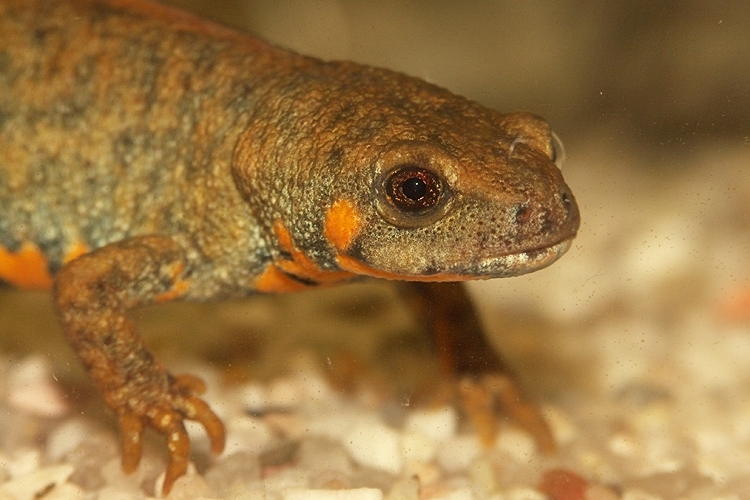
Genuine reasons
- The main threats are no longer present, or conservation measures (e.g., reintroduction, habitat protection or restoration, legal protection, harvest management, etc.) have successfully improved the status of the species enough to move it into a lower category of threat.
- The main threats have continued unabated, have increased, or new threats have developed causing the status of the species to deteriorate enough to move it into a higher category of threat.
IUCN relies on research by scientists working around the world to make new and better species information available to allow Red List assessments to be updated and refined. All reassessments on The IUCN Red List include a record of the reasons for any change in Red List Category, and this allows us to identify which species are genuinely improving or deteriorating in status. Data for species that are genuinely changing status are used to calculate the Red List Index (RLI).
Table 7 shows the list of species that have changed category, along with the reasons for these changes.
An expanding Red List: knowledge gaps and fully assessed groups
In addition to species changing status, The IUCN Red List grows larger with each update as newly described species and species from the less well-known groups are assessed for the first time (Figure 1). IUCN and its partners are working to expand the number of taxonomic groups that have full and complete Red List assessments in order to improve our knowledge of the status of the world's biodiversity; see the Barometer of Life page for more information about this work.
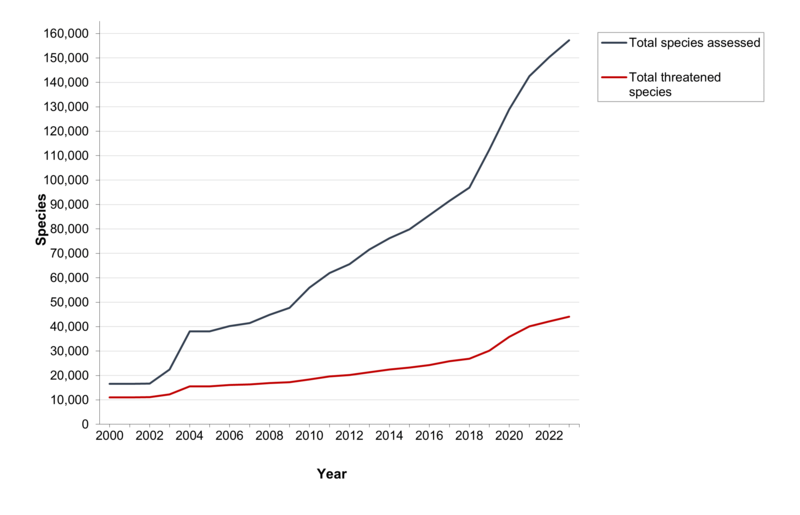
Not all taxonomic groups have been completely assessed (see Table 1 and Figure 2 ). It is very important to consider this when looking at the numbers of species in each Red List Category and the proportions of threatened species within each group; although The IUCN Red List gives a good snapshot of the current status of species, it should not be interpreted as a full and complete assessment of the world's biodiversity. For more information the work underway to expand taxonomic coverage on The IUCN Red List, see the Barometer of Life page.
How many species are threatened?
Species assessed as Critically Endangered (CR), Endangered (EN), or Vulnerable (VU) are referred to as "threatened" species. However, Extinct in the Wild (EW) species can move into the threatened categories following successful reintroduction. Therefore, EW species should be included when reporting proportions of threatened species.
Reporting the proportion of threatened species on The IUCN Red List is complicated because:
- not all species groups have been fully evaluated, and
- some species have so little information available that they can only be assessed as Data Deficient (DD).
For many of the incompletely evaluated groups, assessment efforts have focused on those species that are likely to be threatened; therefore any percentage of threatened species for these groups would be heavily biased (i.e., the % threatened species would likely be an overestimate).
For those groups that have been comprehensively evaluated, the proportion of threatened species can be calculated, but the number of these species is often uncertain because it is not known whether DD species are actually threatened or not. Some taxonomic groups are much better known that others (i.e., they will have fewer DD species), and therefore a more accurate figure can be calculated. Other, less well known groups have a large proportion of DD species, which brings uncertainty into the estimate.
To account for the issues raised above, the proportion of threatened species is only reported for the more completely evaluated groups (i.e., >80% of species have been evaluated). Also, the reported percentage of threatened species for each group is presented as a best estimate within a range of possible values bounded by lower and upper estimates:
- Lower estimate = % threatened and EW extant species if all DD species are not threatened, i.e., (EW + CR + EN + VU) / (total assessed - EX)
- Best estimate = % threatened and EW extant species if DD species are equally threatened as data sufficient species, i.e., (EW + CR + EN + VU) / (total assessed - EX - DD)
- Upper estimate = % threatened and EW extant species if all DD species are threatened, i.e., (EW + CR + EN + VU + DD) / (total assessed - EX)
Note that since extinction risk has been evaluated for less than 5% of the world's described species (see Table 1 ), IUCN cannot provide a precise estimate for how many of the planet's species are threatened. However, overall figures for numbers of species currently assessed in each IUCN Red List Category, along with an indication of which groups have been more comprehensively evaluated, can be found in the Summary Statistics Tables .
An overview of proportions of threatened species within each of the more comprehensively assessed groups is shown in Figure 2. Note that this bar chart groups comprehensively assessed groups of species into classes, with the exception of reef-forming corals (which is an ecosystem-based group that includes species from two separate classes: Anthozoa and Hydrozoa). The intention of this Figure is to present a summary of assessments for groups that have been comprehensively evaluated through the various projects carried out by IUCN, IUCN SSC Specialist Groups, and IUCN Red List Partners. Only groups containing at least 150 species are shown in Figure 2.
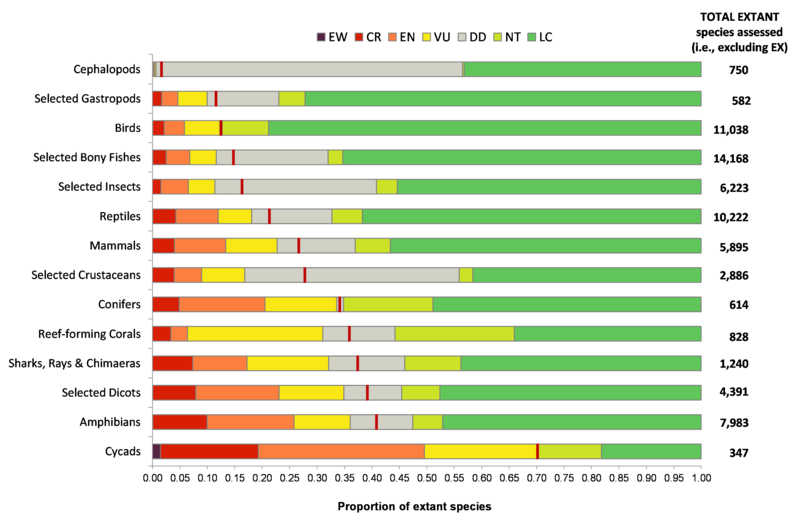
Figure 2. The proportion of extant (i.e., excluding Extinct) species in The IUCN Red List of Threatened Species. Version 2023-1 assessed in each category for the more comprehensively assessed (i.e., at least 80% of the group has been assessed) groups containing ≥150 species. Species are grouped into classes (with the exception of reef-forming corals, which includes species from classes Anthozoa and Hydrozoa), and are ordered according to the vertical red lines, which indicate the best estimate for proportion of extant species considered threatened (CR, EN, or VU) or Extinct in the Wild (EW). Best estimates of percentage threatened species (with lower and upper estimates) for each group are: cycads 70% (70%); amphibians 41% (36-47%); selected dicots 1 39% (35-45%); sharks, rays & chimeras 37% (32-46%); reef-forming corals 36% (31-44%); conifers 34% (34-35%); selected crustaceans 2 28% (17-56%); mammals 26% (23-37%); reptiles 21% (18-33%); selected insects 3 16% (11-41%); selected bony fishes 5 14% (12-32%); birds 12% (12-13%); selected gastropods 4 11% (10-23%); cephalopods 6 1.5% (1-57%). The numbers to the right of each bar represent the total number of extant species assessed for each group. EW - Extinct in the Wild, CR - Critically Endangered, EN - Endangered, VU - Vulnerable, NT - Near Threatened, DD - Data Deficient, LC - Least Concern.
1 Selected dicots includes birches; cacti; magnolias; maples; oaks; protea family; southern beeches; and teas.
2 Selected crustaceans includes lobsters; freshwater crabs; freshwater crayfishes; and freshwater shrimps.
3 Selected insects includes dragonflies & damselflies.
4 Selected gastropods includes abalones; and cone snails.
5 Selected bony fishes includes anchovies, herrings, sardines & relatives; alfonsinos; angelfishes; anglerfishes; arowanas & arapaima; archerfishes; barracuda; beardfishes; billfishes; blennies; bluefish; boarfishes; bonefishes; breams; bristleskins; butterflyfishes; catfishes; characins & allies; clinids; cornetfishes; croakers & drums; cusk eels; dolphinfishes; dragonfishes, lightfishes & relatives; earthworm eels; eels; elephantfishes; fangtooth fishes; filefishes; flounders; freshwater butterflyfishes; galaxiids; gars; ghost pipefishes; gibberfishes; gobies & relatives; groupers; gouramies; grunts; gulpers, snipe eels & relatives; jacks, pompanos & relatives; jellynose fishes; knifefishes; ladyfishes; lanternfishes; lates perches; lizardfishes & allies; louvar; mooneyes; Moorish idol; mudminnows; perches; pikes; pinecone fishes; pufferfishes, triggerfishes & relatives; pricklefishes; salamanderfishes; sand stargazers; scats, porgies & picarels; southern hemisphere smelts & graylings; rabbitfishes; ricefishes; ridgeheads; sea basses; seahorses, pipefishes & relatives; shrimpfishes; silversides; shellskin alfonsinos; slimeheads; snaketooth fishes; snakehead fishes; snappers; snooks; soles; spinyfins; sticklebacks; sturgeons & paddlefishes; suckerfishes; surgeonfishes, tangs & unicornfishes; swordfish; tarpons; temperate basses; threadfins; tonguefishes; torrentfish; trumpetfishes; tube-eyes; tubesnouts; tunas; turbots; velifers, opahs & ribbonfishes; viviparous halfbeaks; wrasses; whalefishes; and wreckfishes.
6 Cephalapods includes nautiluses; octopuses; and squids.
Summary Tables
Tables 1 & 2: threatened species in past and present iucn red lists.
Tables 1 and 2 are organized by taxonomic group and show numbers of threatened species listed in the current version of The IUCN Red List in relation to the estimated number of described species (Table 1a), and numbers of threatened species in each version of The IUCN Red List since 1996 (Tables 1b and 2). These tables highlight the disparity between the number of described species and the number of species that have been assessed. They also provide a summary of overall changes in numbers of threatened species on The IUCN Red List over the last twenty years, however please note that there are many different reasons for these figures changing between different versions of The IUCN Red List (see A Dynamic Red List: reasons for changing status above).
Tables 1 and 2 are currently available as PDF documents only.
Table 1a - Number of species evaluated in relation to the overall number of described species, and numbers of threatened species by major groups of organisms.
Table 1b - Numbers of threatened species by major groups of organisms (1996–2023).
Table 2 - Changes in numbers of species in the threatened categories (CR, EN, VU) from 1996 to 2023.
Tables 3 & 4: Summaries by taxonomic group
Tables 3 and 4 are organized by taxonomic group. These should be used to see, for example, the numbers of globally threatened mammals, birds and amphibians (Table 4 is an expanded version of Table 3).
These tables include number of species tagged as 'Possibly Extinct' (CR(PE)) and 'Possibly Extinct in the Wild' (CR(PEW)). These figures are included to give an upper estimate for total number of recently extinct species on The IUCN Red List. Combining the total numbers of EX and EW species gives the total number of actual extinctions recorded (since 1500 AD); when CR(PE) and CR(PEW) species are also included, the resulting figure is an estimate of number of recent extinctions when uncertainty is taken into account.
Tables 3 and 4 are interactive. Each column can be ordered (descending or ascending), and the numbers include links to search results on the website showing the lists of species represented in the tables.
Table 3 - Number of species in each IUCN Red List Category by kingdom and class.
Table 4a - Number of animal species (kingdom: Animalia) in each IUCN Red List Category by class and order.
Table 4b - Number of plant species (kingdom: Plantae) in each IUCN Red List Category by class and family.
Table 4c - Number of fungus species (kingdom: Fungi) in each IUCN Red List Category by class and order.
Table 4d - Number of chromist species (kingdom: Chromista) in each IUCN Red List Category by class and order.
Tables 5 & 6: Summaries by country
Tables 5 and 6 are organized by country. These should be used to see, for example, number of globally threatened mammals or the numbers of Critically Endangered species occurring within a specific country.
The figures presented in Tables 5 and 6 include only certain distributions, reintroduced species and regionally extinct species (i.e., the figures exclude all uncertain distributions, introduced species and vagrant records).
Important note : the figures presented in Tables 5 and 6 differ from the default setting for country searches on the website. The default search includes ALL occurrences within each country (i.e., including introduced species, vagrant records, etc.). To modify country searches on the website to match the tables below, use the Country Legends filters on the Advanced Search page to show species tagged as ' Extant ', ' Extant & Reintroduced ', ' Extinct ', ' Extinct & Reintroduced ', ' Possibly Extinct ', and ' Possibly Extinct & Reintroduced '.
For wide-ranging marine species, country records are provided in assessments only where data are available for this. These records are also included in Tables 5 and 6.
Tables 5 and 6 are interactive. Each column can be ordered (descending or ascending), and the numbers include links to search results on the website showing the lists of species represented in the tables.
Table 5 - Number of threatened species (Critically Endangered, Endangered and Vulnerable categories only) in each major taxonomic group by country.
Table 6a - Number of animal species (kingdom: Animalia) listed in each IUCN Red List Category by country.
Table 6b - Number of plant species (kingdom: Plantae) listed in each IUCN Red List Category by country.
Table 6c - Number of fungi species (kingdom: Fungi) in each IUCN Red List Category by country.
Table 6d - Number of chromist species (kingdom: Chromista) in each IUCN Red List Category by country.
Table 7: Species changing Red List Category
Table 7 is organized by taxonomic group. This table should be used to check which species have changed Red List status since the previous Red List update and the main reason for the status change. Table 7 is provided here for the current Red List and for previous Red Lists (dating back to 2007).
Important Note: Table 7 is provided only to summarize the reasons for species changing category between one Red List update and the next. This table should not be used to calculate a Red List Index (RLI); for this it is necessary to analyse the underlying Red List data to identify genuine status changes between specific years for specific taxonomic groups. See the Red List Index page for more information about RLIs.
Table 7 is currently available as PDF documents only.
Table 7 (2022-2023) - Species changing IUCN Red List Category between 2022 and 2023.
Table 7 (2007-2022) - Species changing IUCN Red List Category each year between 2007 and 2022 (zip file containing separate tables for each year). Note that in 2007, Table 7 included species that were removed from the Red List for taxonomic reasons, and in 2008 Table 7 included genuine status changes only.
Table 8: Endemic species by country
Table 8 is similar to the country tables (Tables 5 and 6), but focus on endemic species only (i.e., species occurring naturally within one country only). This table only presents figures for the comprehensively assessed species groups (i.e., where >80% of the species in the group have been assessed). Note that the Advanced Search page includes a filter for endemic species, which should be used in combination with the land regions filters to see lists of endemic species for all taxonomic groups.
Table 8 should be used to check, for example the total number of endemic mammals, and the number of threatened and Extinct (EX) or Extinct in the Wild (EW) endemic mammals within a specific country.
Tables 8a, b, c and d are currently available as PDF documents only.
Table 8a - Total, total threatened, and total EX or EW endemic bird, mammal, reptile and amphibian species in each country for groups where >80% of species in the group have been assessed (totals by taxonomic group).
Table 8b - Total, total threatened, and total EX or EW endemic fish species in each country for groups where >80% of species in the group have been assessed (totals by taxonomic group).
Table 8c - Total, total threatened, and total EX or EW endemic invertebrate species in each country for groups where >80% of species in the group have been assessed (totals by taxonomic group).
Table 8d - Total, total threatened, and total EX or EW endemic plant species in each country for groups where >80% of species in the group have been assessed (totals by taxonomic group).
Possibly Extinct species
The number of recent extinctions documented by the Extinct (EX) and Extinct in the Wild (EW) categories on The IUCN Red List is likely to be a significant underestimate. The tags 'Possibly Extinct' (CR(PE)) and 'Possibly Extinct in the Wild' (CR(PEW)) have therefore been developed to identify Critically Endangered (CR) species that are likely to already be extinct (or extinct in the wild), but for which confirmation is required.
Figures for CR(PE) and CR(PEW) species (Table 9 in previous IUCN Red Lists) are now available in the automated summary statistics tables , which include embedded hyperlinks to the species lists in the Advanced Search page. To get the list of species only (i.e., excluding subspecies and varieties), make sure the Species checkbox is ticked (in the INCLUDE section in the bottom left of the Advanced Search page).
You must log in to access advanced IUCN Red List functionality. Please enter your e-mail address and password below.
To save searches and access a historical view of information you have downloaded you are required to register for an account.

OUR CENTRAL IDEA

Our Central Idea!!
The central idea is the main idea
a, we will research to get a better undestanding about the central idea. Our central idea is cruelty to animal may cause conflicts. However you have different thing coming out of the central idea. An good example is the lines of inquiry, cause the central idea is going to be so big, we will need to make it simpler to research. We think the central idea means that cruelty to animals can make conflicts because people in organizations that are helping animals are fighting with cruel people who are hurting the animals. We believe the central supposed to be realeted everything, and we think that after our research.
![central idea assignment endangered animals user-d6kyo9ri4h3jcqtq8nlynrfp1-thumbs-ZwZi3kJNQ9K2o9mRDJD7_DSCN0497[1]](https://static.wixstatic.com/media/e51552_0b22ae70b1654d90be613c731b1cee3f.jpg/v1/fill/w_480,h_360,al_c,q_80,enc_auto/e51552_0b22ae70b1654d90be613c731b1cee3f.jpg)

IMAGES
VIDEO
COMMENTS
An endangered species is a type of organism that is threatened by extinction. Species become endangered for two main reasons: loss of habitat and loss of genetic variation. Loss of Habitat. A loss of habitat can happen naturally. Nonavian dinosaurs, for instance, lost their habitat about 65 million years ago.
In the last 40 years, the Endangered Species Act has proved to be a remarkably successful tool for preventing extinction and steadily improving the conservation prospects for numerous dwindling species. Although significant progress has been made in safeguarding our nation's imperiled species, many still face formidable challenges to recovery. Many species continue to hang on by just the ...
What are some animals you think are threatened or endangered? (You may wish to talk about the difference between a species being endangered and a species being threatened. An endangered species is one that is in danger of extinction throughout all or a significant portion of its range. A threatened species is one that is likely to become an endangered species within the foreseeable future ...
Synopsis: This resource is a collection of free materials about endangered species and answers some essential questions about this topic. The four articles include information on: Endangered species, biodiversity and evolution, preserving habitats and protecting wildlife and the human impact on these animals. Students should read the "What is an Endangered Species" article. The Expert Pack ...
This lesson plan engages students by applying what they have learned about main idea and extends their learning about endangered animals like the rhinoceroses in Africa and the Indian python snake from India. Students review main idea and learn to use the boxes and bullets strategy to organize the notes they find while reading nonfiction texts. This lesson was developed by Ashley Wondra as ...
Central Ideas and Details — Worked example. Learn the best way to approach a central ideas and details question on your SAT. Start by stating the main idea of the text in your own words, then find the choice that best matches your summary, using the process of elimination. Remember, everything you need is in the text.
The Endangered Species Act (ESA) of 1973 obligates federal and state governments to protect all life threatened with extinction, and this process is aided by the creation and continued maintenance of an endangered species list, which contains 1,662 domestic and 686 foreign species of endangered or threatened animals and plants as of 2019.
Thankfully one area of learning that was beginning to become of more importance was the idea of endangered animals and the affect of human impact on the animals habitat. As the children researched their animal it was evident that many of the animals were being affected by the activities of humans.
Students are invited to address this overwhelming problem in a more focused, manageable manner by turning their attention to one endangered species within one of Earth's biomes. Students research human factors, like patterns of human settlement and land use, and environmental factors, like climate patterns and natural disasters, that have driven these animals toward extinction. Then ...
Persuading others to preserve wildlife. Proudly telling the world about #generationIB in our 50th anniversary year. PYP students convince community to save endangered species. A trip to the zoo turned into an ongoing service project for Primary Years Programme (PYP) students at St Ann Catholic School, in West Palm Beach, USA.
1. Introduce your students to the idea that animals and plants need homes, or habi-tats, just like people. The area that an animal needs to find its food, water, cover, and places to raise young is called its habitat, and areas of the country or world where its habitat can be found are called home ranges. Your students will be noting species' home ranges on a United States map.
Central Idea. Free lesson plans and resources to help your students identify topics, central ideas, and supporting details. Resources utilize short passages and focus on both stated and implied central ideas. Download all materials.
Students will learn to find main idea in a nonfiction text about endangered rhinoceroses. Main idea should be taught prior to this lesson using reading strategies. Students should already know main idea is what the text is mainly about in one sentence. Students should be able to locate the main idea in the topic sentence, heading, last sentence of the text, and know it may be found in text ...
Animal farm, part 3: central idea development. mr. Jones overworks and abuses the farm animals, old major urges the animals to rebel and take over the farm. The animals successfully Revolt after old major dies, and the pigs create the seven Commandments based on Old Major's teachings. Under Napoleon's watch, the milk has disappeared.
2023 marked the 50th Anniversary of the Endangered Species Act, a landmark piece of legislation protecting fish, plants, and wildlife. There are many exciting ways for children, families, K-12 students, college students, and educators to engage in celebrating the 50th Anniversary into 2024! Questions can be directed to Tara at the Endangered ...
Begin the lesson by writing the phrase central idea on the board. Have students brainstorm what a central idea is. Next, ask students how they determine a central idea in a text that they are reading. Share with students that the central idea of a text tells you what that text is mostly about. However, in a science text, the central ideas are sometimes conclusions the author draws. When an ...
b. The leaders believe that they should get more privileges than the laborers. Which details develop the central idea that the leaders believe that they deserve more than the other animals? Check all that apply. c. "The animals had assumed as a matter of course that these would be shared out equally." d. "All the windfalls were to be collected ...
October 14, 2015. The black-footed ferret's tale of near-extinction is just one of many stories of endangered animals. USFWS Mountain Prairie. The idea of extinction is pretty straightforward ...
Extinction of species has occurred as a natural process since life began on Earth, but human activities have greatly accelerated the rate of extinction in recent years. Among the many factors that may contribute to the disappearance of a species are habitat destruction, over-exploitation, introduction of exotic species, and climate change. Endangered animals face extinction in all or a part of ...
Only groups containing at least 150 species are shown in Figure 2. Figure 2. The proportion of extant (i.e., excluding Extinct) species in The IUCN Red List of Threatened Species. Version 2023-1 assessed in each category for the more comprehensively assessed (i.e., at least 80% of the group has been assessed) groups containing ≥150 species.
Explore the research and academic work of Southern Illinois University Carbondale at OpenSIUC.
The central idea is the main idea. a, we will research to get a better undestanding about the central idea. Our central idea is cruelty to animal may cause conflicts. However you have different thing coming out of the central idea. An good example is the lines of inquiry, cause the central idea is going to be so big, we will need to make it ...